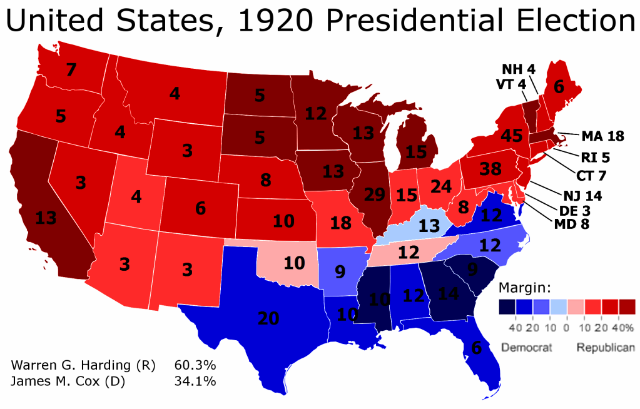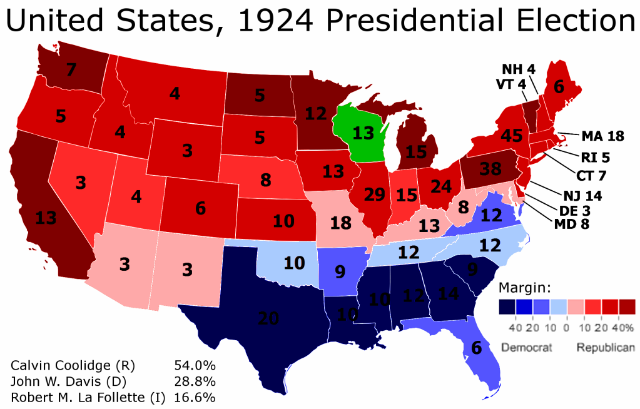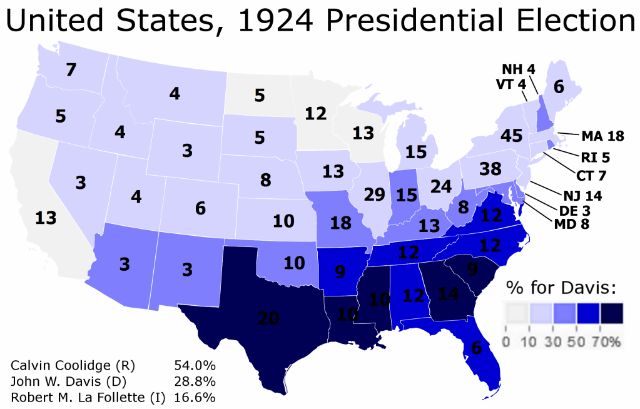Continuing to gratify my curiosity about what the exit poll data looks like when mapped, I was looking at what they said about the number of voters who approve of the Republican Party and the Tea Party movement, respectively.
Nationally, as I noted in the previous diary, 42% of the voters expressed a favorable opinion of the Republican Party. Unfortunately, the same question wasn't exactly asked about the Tea Party. Instead, the exit poll asked voters: Do you support or oppose the Tea Party movement? A total of 40% responded that they somewhat or strongly supported it. Very close to the number of people who thought favorably of the GOP. But are they necessarily the same people?
Just to throw in a couple more layers:
- According to the exit poll, no less than 41% of the voters identified themselves as conservative. This is, as DCCyclone commented on the previous diary, an upset: in the past, self-described moderates always outnumbered conservatives, but this time conservatives formed the largest group.
- Only 36%, on the other hand, identified themselves as Republican, when asked "No Matter How You Voted Today, Do You Usually Think Of Yourself As A Democrat / Republican / Independent?".
I compiled these data, state by state, in this Google Docs spreadsheet.
42%, 40%, 41%, 36% – these numbers are all quite similar. The biggest similarity, however, is between Tea Party supporters and conservative self-identifiers. Taken state by state, the difference between these two values by state was an average of just 2.6%. By comparison, the difference between any other pair of these four values ranged between 4% and 9%.
So how do the maps compare?
Somewhat or strongly support the Tea Party movement

Considers oneself, on most political matters, a conservative

Again, I used the Google Charts Wizard to create the maps, and they're really plain, and annoyingly, I didn't figure out how to include legends. Or titles. If someone knows how to tweak the URL to include them, or has a easy mapping tool to suggest, thank you.
In lieu of a legend, though: all these maps are set to the same scale, and basically, bright green stands for 25%; yellow for 37.5%; and bright red for 50%.
Top and bottom of the hit lists are roughly the same. Texas is the reddest state of all (ex aequo with Arkansas when it comes to conservatives). Indiana and Arizona are up next when it comes to Tea Party states, with South Carolina and Arkansas coming next, while it's roughly the other way round for the number of conservatives. Vermont and Hawaii dangle at the greenest end (or bluest, really), with far fewer Tea Party supporters than anywhere else.
Tea Party – the mild appearance of the conservative movement?
However much some Tea Party cheerleaders like to describe it as a fiercely independent movement with people from all kinds of backgrounds, it is striking how closely the number of people who support the Tea Party hews to the share that identifies itself as conservative. In 20 out of 26 exit poll states, the difference between the two numbers is no more than 3%. The only exceptions are NY, CT, DE and PA, where Tea Party support is 4-6 points higher than conservative self-identification, and SC, AR and LA, where conservative identification is 5-8 points higher than Tea Party support.
That suggests an interesting regional pattern. Unlike you'd maybe expect, the 'Tea Party' label apparently elicits less resistance in some of the liberal states, and less passion in some of the conservative states, than the label 'conservative' itself. I associate the Tea Party movement with irrational rage, myself, but this suggests that, if anything, it functions as a somewhat milder rebranding of conservatism – like "progressive" being substituted for "liberal"?
Tea Party support – only marginally dependent on individual candidates?
You'd expect the presence of local Tea Party champions running heated Senate campaigns to have an impact on how many people support the Tea Party movement, but it doesn't necessarily seem so. Rand Paul, Ayotte, Rubio, Johnson, Buck, Angle and McDonnell ran in very different states, but the level of Tea Party support in their states in all of them was a fairly consistent 35-43%. Neither does there seem to be much pattern in how Tea Party support in those states compares with sympathy for the GOP or conservative self-identification.
In WI, NH and KY, the homestates of Johnson, Ayotte and Paul, Tea Party support badly lagged GOP favorability (map below). But in Ken Buck's Colorado, it was GOP favorability that lagged, and in the homestates of McDonnell and Angle, the posterboys of Tea Party failure, the numbers pretty much aligned.
Compare Tea Party support with conservative self-identification and the dice roll differently. In Nevada, conservatives outnumbered Tea Partiers. But before you count that as a sign of Angle's weakness, the number of Tea Party supporters in Delaware, O'Donnel's home state, clearly outnumbered the number of conservatives.
In short, it's possible that these candidates collectively dragged down the numbers of Tea Party supporters, conservatives as well as GOP sympathizers, but they don't seem to have particularly affected the Tea Party's standing in particular. Or at least any such effect is drowned out by more structural factors determining conservative and GOP affinities.
More maps:
Favorable opinion of the Republican Party
Usually thinks of oneself as a Republican
There's a striking difference between this pair of maps, but it's a pretty obvious one: there's a big gulf between expressing a favorable opinion of the GOP and actually thinking of oneself as a Republican.
The difference is by far the biggest in Arkansas and New Hampshire, presumably for very different reasons. (New Hampshire has a big tradition of voters identifying as Independents, while Arkansas still presumably has many Dixie Democrats. Or at least former Dixie Dems who've started considering themselves Independents but aren't quite ready to embrace the GOP, even if they've come to have a favorable opinion of it.) In Arkansas, 51% of the voters thought favorably of the GOP, but only 29% identified themselves as Republican. In New Hampshire, that was 48% and 30%. And in no less than 11 of the 21 states where both questions were asked, 9-12% more people expressed a favorable opinion of the GOP than identified themselves as a Republican. Theoretically, I suppose, could you see those states as possible "growth areas" for the GOP?
California, Oregon and Pennsylvania form an interesting contrast. While more Pennsylvanians identified themselves as Republican (37%) than did Oregonians (27%) and Californians (30%), Republican appeal in all three states is basically limited purely to those actively identifying themselves as such. In each state, there's just 3-4% voters who doesn't identify as Republican but could, judging on their favorable opinion of the party, soon start to.
Republican self-identification vs the other maps
When you look at the map of the GOP's favorability rating, while the absolute values are clearly lower than in the maps further above on conservatives and Tea Party supporters, there's at least a striking similarity in the relative order of things. No matter whether you look at the most conservative, Republican or Tea Party-friendly states, among those on which exit polls were published, Arkansas, Texas and South-Carolina are in the top 5. Among the states where all three questions were asked, California is always in the bottom 3, and Oregon and Delaware are in the bottom 5.*
The map showing Republican self-identification, on the other hand, doesn't quite match up. Most strikingly, Arkansas is only the shared 19th most Republican state. Considering that there are almost double as many conservatives as there are Republicans in the state, about a third of the Democrats and Independents in Arkansas must describe themselves as conservative. The same must have held true in other Southern states not long ago, but judging on the numbers for South-Carolina, Louisiana and even Missouri, many more conservatives there have already just started identifying themselves as Republican too.
Tea Party support vs Republican favorability
While the national difference between Republican favorability and Tea Party support was small, there are only a few exit poll states where Tea Party support was higher than GOP favorability. They were Oregon (36% vs 30%), Colorado (41% vs 38%), Washington (37% vs 35%), and two states where the difference was just one point (California and Ohio). The West Coast seems to like the Tea Party better than the GOP – though it doesn't seem to particularly like either. Next up in line are Arizona, where GOP favorability was just 1 point higher than Tea Party support, and Nevada, Pennsylvania and Delaware, where it was 2 points higher. Still a lot of Western states in this list.
There was a larger number of exit poll states where Republican favorability was the higher value, and here the difference was sometimes large. In South Carolina, GOP favorability was ten points higher than Tea Party support (53% vs 43%), though both numbers were above-average. In Iowa (45% vs 36%) and Wisconsin (46% vs 37%) it was nine points higher; in Arkansas (51% vs 43%) it was eight.
I was quickly tempted to say something about the Upper Midwest and the South being less specifically Tea Party-friendly than the West, or something, but that's wrong of course. The Tea Party movement is more popular in Arkansas and South-Carolina than in CO, NV, WA, OR or CA. It's just that the difference between the values for the GOP and the Tea Party are most in the GOP's favour in SC, AR, IA and WI, and in the TP's favour in WA, OR and CO.
Basically, it seems that much like was the case with the "conservative" vs the "Tea Party" labels, the Republican Party brand, perhaps surprisingly, is somewhat more polarizing than that of the Tea Party movement. The standard deviation for the state-by-state GOP favorability numbers is 6.3 and that for conservative self-identification is 7.1; whereas for Tea Party support it's a somewhat smaller 5.3.
(For the Democratic Party's favorability ratings, meanwhile, it's just 4.4, suggesting that the party's support is more evenly spread across state than the GOP's. Part of that is surely due to Dem-voting minorities in otherwise red states, but either way it can't be strategically advantageous, can it, when it comes to winning Senate seats and Electoral Votes for the Presidency? It means that more votes get 'lost' in hopeless states, though I suppose it also means that fewer excess votes are wasted in safe states.)
————
* OK, cheating just the smallest bit: on the conservative share of the electorate, Oregon is shared 5th/6th/7th lowest.





